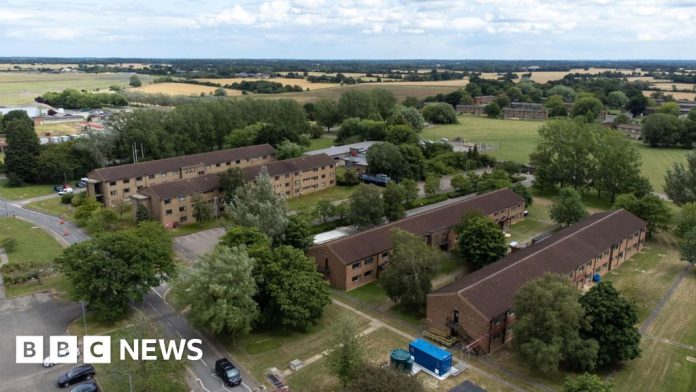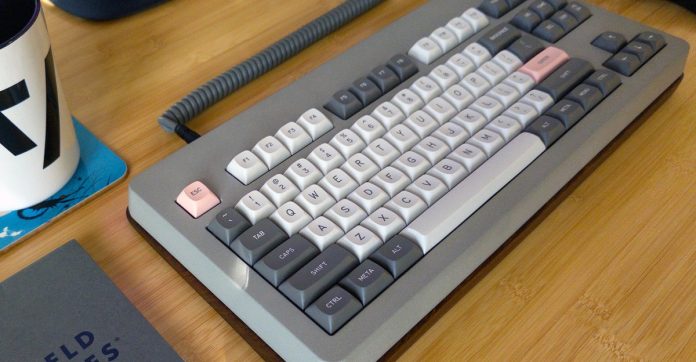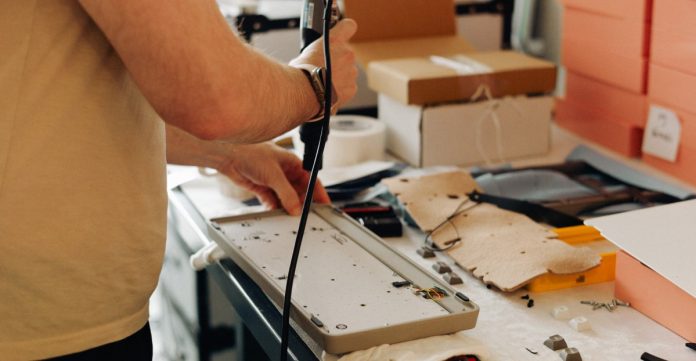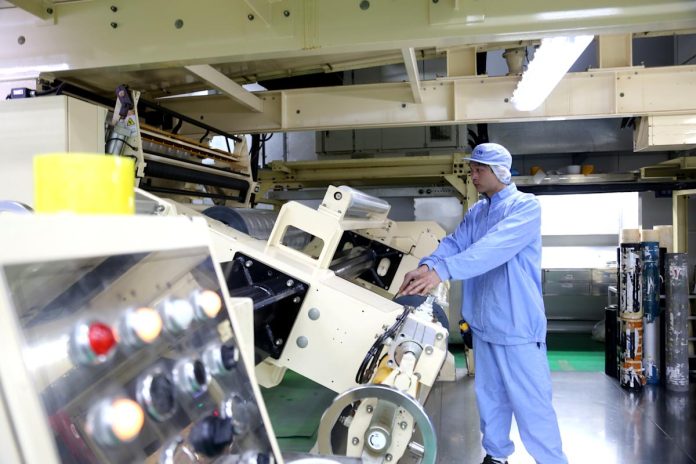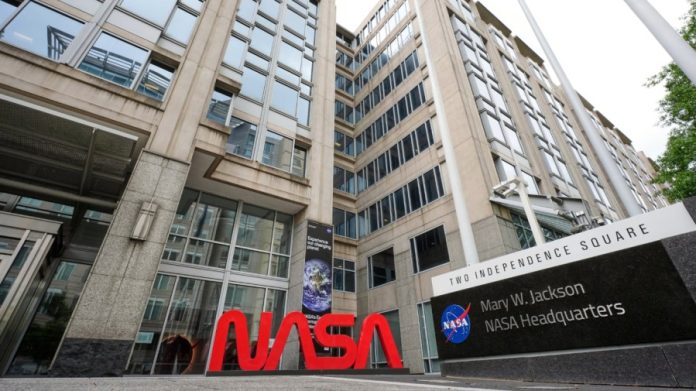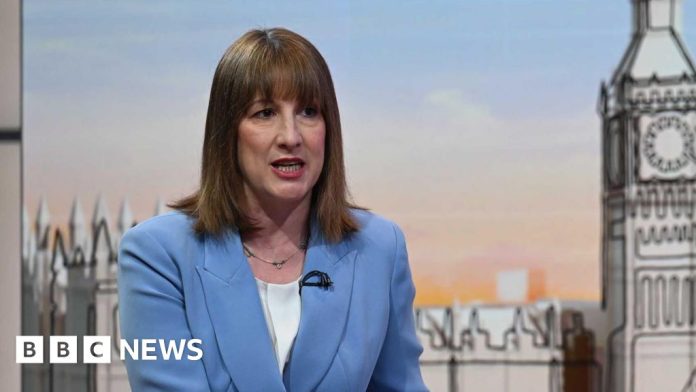The term “endgame,” among keyboard enthusiasts, is sort of a running gag. Endgame is when you finally dial in your perfect layout, case, features, switches, and keycaps, so you can stop noodling around with parts and get on with whatever it is you actually use the keyboard for — work, presumably. Then a few months later you see something shiny and start over.
In the search for endgame, most of us have to compromise somewhere — usually time or money. Sometimes the thing you’re looking for just doesn’t exist.
But what if you didn’t have to compromise? What if you had the time, the patience, the creative vision, and the cash to create your endgame keyboard from scratch? And I mean really from scratch, from the cable to the switches and stabilizers.
This is how you get the Seneca, the first keyboard from Norbauer & Co. It has a plasma-oxide-finished milled aluminum chassis, a solid brass switchplate, custom capacitive switches, the best stabilizers in the world (also custom), spherical-profile keycaps with appropriately retro-looking centered legends, zero backlighting, and a completely flat typing angle.
The Seneca.Photo by Nathan Edwards / The Verge
It weighs seven pounds and costs $3,600.
You might have some questions, like: Why is it $3,600? Who would make a keyboard that’s that expensive? And is it even any good?
I’ve spent the last couple of months typing on an early Seneca, and the answer to the last question is the easiest. Yes. It’s incredible. It’s certainly the nicest keyboard you can buy. The build quality is astonishing, the Topre-style switches are better than Topre’s, the stabilizers are better than anyone’s, and the keyboard is beautiful and a joy to type on. The Seneca is a genuine technical accomplishment.
The answer to the first two questions is Ryan Norbauer.
Ryan Norbauer is well known in the keyboard community for his aftermarket housings, but the Seneca is his first ready-to-type board. To hear him tell it, it’s the latest logical step in a decadelong process to build his own endgame keyboard, of which the business — Norbauer & Co. — is an almost accidental byproduct.
Ryan NorbauerPhoto by Taeha Kim
Norbauer grew up in West Virginia in the 1990s, watching Star Trek: The Next Generation and absorbing both its retro-modern aesthetic and its vision of an egalitarian, post-scarcity world. It was also the beginning of the personal computing era and the dawn of the internet. The computer represented an escape from the world as it is, a window into the future of Star Trek, of Epcot, of the idea that a more connected world would be a better one.
The Seneca represents Norbauer’s attempt to make the best possible computer keyboard, to his own standards and tastes, without worrying about cost — the kind of keyboard that looks and feels like we remember keyboards feeling, back when we thought computers were a good idea.
“A big part for me of the allure of keyboards is the connection to my childhood nostalgia about being really excited about computing,” Norbauer tells me via video chat. So the Seneca is big, chunky, and has a standard tenkeyless layout, rather than something more compact or exotic, because that’s what he’s always used, and what brings back that feeling. “I feel like I can more authentically make an optimal keyboard if the first one I make is exactly the one that I want.”
Norbauer has a habit of wanting things that don’t exist, then figuring out how to build them from scratch. About 20 years ago, he got an idea for a dating website. “I didn’t have any money at all. I dropped out of a PhD program and I just had this idea for a company I wanted to start and I couldn’t hire anyone to code it for me. So I’m like, ‘Okay, I guess I just have to learn how to code.’”
He spent six months coding for 14 hours a day; this got him a website, a startup, and tendonitis. Fixing the tendonitis involved adopting proper typing form (wrists straight, hands hovering over the keyboard like a pianist’s). Searching for a more comfortable keyboard eventually sent him down the path of an obsession.
The dating website led to two more startups. Selling all three startups in 2010 gave him the time and money to explore new interests: at first, learning some industrial design skills so he could make Star Trek prop replicas. It also led him to Topre keyboards.
Topre switches — most famously found in the Happy Hacking Keyboard — have a rubber dome under each key, instead of a physical switch. Pushing the key collapses the dome, which compresses a conical spring; a capacitive circuit under each key senses the change in capacitance and, at a certain threshold, registers a keypress. Releasing the switch snaps the dome back into place.
Topre keyboards are rare compared to mechanical keyboards using Cherry MX-style switches. Only a few companies ever made them, so there aren’t many layout options, and they tend to be more expensive, with fewer features for the money. They’re also harder to customize, with only a few different dome options; they also aren’t compatible with most aftermarket keycaps out of the box. And while metal cases are common in enthusiast mechanical keyboards, Topre keyboards only come in plastic. But Topre boards have a dedicated fan base because the domes give Topre switches a snappy tactility you can’t otherwise replicate.
By 2014, he was using a modified Topre Realforce 87u keyboard in an aftermarket aluminum housing. He was also designing a Star Trek-inspired keycap set. Like most aftermarket keycaps, it worked with Cherry MX-style mechanical switches; Topre boards have a different keycap mount. So he couldn’t use his Star Trek keycaps on his favorite keyboard.
But then Cooler Master came out with the NovaTouch, which had Topre switches but worked with regular keycaps. Norbauer got one, but its cheap plastic housing didn’t feel right. He couldn’t find anyone to make him an aluminum housing for it. “So I just said, ‘Fuck it, I’ll figure it out myself.’”
Norbatouch prototypes, with Norbauer’s Galaxy Class keycaps on the board on the right. Photo by Ryan Norbauer
A beige Norbatouch with Galaxy Class keycaps.Photo by Norman Chan / Tested.com
He designed a housing and learned enough machining to make a prototype on a WWII-era milling machine. Once he was satisfied with the design, he found a manufacturer and launched a small group buy on a keyboard forum and asked if any other Topre diehards wanted one, to cover the costs of making one for himself.
He figured it was a one-time thing. “It was never intended to be a business, but people just kept asking me to make more and more, and the thing kind of snowballed on its own.” He did a few more rounds of the case eventually dubbed the Norbatouch, in a few new colors, including a beige to go with his now officially licensed Star Trek keycaps. Then, because people kept asking, he started making housings for other Topre keyboards.
There was the Norbaforce, for Realforce tenkeyless keyboards, and the Heavy-6 and Heavy-9, for the Leopold FC660C and FC980C, respectively. And in 2020, there was the Heavy Grail, his most popular housing, for the Happy Hacking Keyboard.
Each was a chance to refine his aesthetic and his manufacturing capability, and to experiment with different materials (steel, titanium, milled polycarbonate, copper) and finishes (polishing, bead-blasting, anodizing, powdercoating, cerakote, electroplating, even verdigris).
1/7The Norbaforce in VHS finish.Photo by Norbauer & Co
But they’re still only housings, not the keyboards themselves; to complete them, you still have to shuck a $200-plus keyboard from its plastic shell and stick it into the Norbauer housing. Making housings for other companies’ keyboards put him at the mercy of their supply chains and design decisions. The Novatouch was discontinued several months before his first batch of casings was ready; supply of Leopold’s keyboards was unpredictable even before the company stopped making them.
He also wanted more control over the other aspects of the board, and he wanted something to offer people who like the Norbauer aesthetic but aren’t up for buying a keyboard, cracking it open, voiding the warranty, and transplanting the guts into a new case.
When I first emailed Norbauer in late 2018, he was already talking about building a ready-to-type keyboard — something people could pick up and enjoy right away. “I didn’t know exactly what that would look like, and I certainly didn’t know how hard it would be to get to that point. If I did, I probably never would have undertaken it.”
He made a prototype using off-the-shelf parts — standard MX-compatible switches and stabilizers — then scrapped it. There are already dozens of companies making custom keyboards.
Instead, he decided to create the thing he’s wanted all along: a keyboard with a heavy metal chassis and his own retrofuturistic aesthetic, with the snappy tactile feedback of a Topre-like capacitive dome switch and compatibility with the wide world of aftermarket keycaps.
“It was one of those things where my ambitions just kind of spiraled out of control.”
He hired an electrical engineering firm to design the PCB, which he figured would be the hardest part, since Topre switch clones are pretty easy to come by. That took about a year, on and off. “And then I realized, ‘Shit, I guess I have to make all the other stuff that goes with it.’ And that took about five years.”
Somewhere along the line, the project turned into a deliberate exercise in making the best keyboard he possibly can, regardless of cost. “It was one of those things where my ambitions just kind of spiraled out of control.”
For example: Topre switches feel great to type on, but they tend to be wobbly at the top — understandable for something sitting on top of a rubber dome — and keycaps often end up slightly crooked. He wanted a slightly deeper typing sound, and he wanted proper compatibility with MX-style keycaps. It’s not enough to swap the slider for one with the plus-sign -shaped MX stem, like other companies do; you also have to redesign the housings, or the keycaps just end up slamming into them.
He figured he could do better. His first prototypes sounded great, but they were just as wobbly as Topre. His second design had tighter tolerances, so it wobbled less, but it sounded worse. He added more material to get a deeper sound. Each revision required another (expensive) round of injection-molded tooling as he searched for the best combination of feel and sound.
The Norbauer switch (right) has an MX-compatible stem, designed to exert the minimum force needed to keep the keycap in place. Lower left is a stock Topre stem, and top is a Deskeys aftermarket stem.Photo: Nathan Edwards / The Verge
By the fourth revision — the ones in the Seneca — the switches don’t look much like Topre. He redesigned the housings to avoid interference with MX-style keycaps, and added a third alignment leg to the sliders; they don’t rotate as easily in the housings, so the keycaps aren’t crooked. They have the high tactile bump and smooth downstroke of Topre switches, with a deeper sound. There’s a silicone ring for upstroke damping, and a gasket where they press against the underside of the brass switchplate.
While he was working on the switches, he tackled the stabilizer problem. Stabilizers are the mechanisms that connect to long keys, like the space bar, shift, enter, and backspace, and make sure the whole key moves downward at the same rate regardless of where it’s pressed. They work, but they sound terrible, unless you find some way to stop the wire from rattling in the housing, the slider from slamming into the PCB, and the various plastic parts from rubbing together. Usually this involves some combination of lubes, greases, and physical damping. Tuning the stabilizers is the most time-consuming and tricky part of most keyboard builds.
“The original plan was to use hand-lubed MX stabilizers because it’s such a standard thing, right? But I thought it just would be interesting to see if there was some way to solve this problem without requiring it all to be based on lubrication to dissipate the sound.”
Norbauer wanted the Seneca to be the best keyboard in the world, so he had no choice. He had to make the best stabilizers in the world.
Custom switches, custom stabilizers, and a 5mm chromed brass switchplate.Photo by Nathan Edwards / The Verge
Developing the Seneca’s stabilizers took several years, a bunch of false starts, and, in his words, a “personal cash bazooka.” His first attempt, mostly on his own, resulted in what he considered a “90 percent solution” — better than anything on the market, without lube. But 90 percent there is 10 percent not there. He started over.
He worked with a firm that specializes in kinematics to develop a totally new stabilizer mechanism. Actually, they came up with two new stabilizer mechanisms. The first is a compliant-beam design that’s significantly better than existing stabilizers as well as his first prototype. It’s much less prone to rattle or tick. It’s as close to perfect as you can get without totally rethinking how stabilizers work. The second design is a complicated series of pin-joint hinges with five times as many parts as a standard stabilizer. It’s hideously expensive to produce and both time consuming and fiddly to assemble, but it’s better.
The Seneca uses the second design.
This is illustrative of Norbauer’s general approach, which is that solving technical problems is much more interesting than trying to minimize production costs. On the Seneca, that’s taken to a deliberate extreme. “Our goal is just to make this good, and that’s all that matters. And so whenever there was a branch, I was like, ‘Let’s go with the rightest way to do it and damn the costs.’ And that has been the philosophy of this board.”
The Seneca’s case is milled from solid aluminum, with an MAO plasma-oxide finish; he had to set up a company in China in order to source it. There’s a warm gray option called travertine, which has a matte, slightly speckled stonelike look, and a lighter gray called oxide, which looks a bit like concrete. They’re both smooth to the touch. (There’s also a matte black version, which I haven’t seen in person, and a nearly $8,000 titanium option, which ditto.)
A Seneca mid-assembly, viewed from the underside. You can see the flexible dome and conical spring for each key resting in the switchplate, before the PCB is attached. The modifiers use heavier domes than the alpha keys by default.Photo: Taeha Kim / Norbauer & Co
The switchplate is milled from solid brass, for the acoustic properties, and then chrome-plated for aesthetics. Aluminum would have been cheaper, lighter, and easier to mill, but brass absorbs sound better, so brass it is. The PCB contains a galvanic isolation chip to mitigate the incredibly unlikely event that a rogue power supply sends a blast of electricity from the computer’s USB port into the keyboard. The cable has an obscenely expensive Lemo connector on the keyboard side. Lemo connectors are more secure than USB and Norbauer thinks they’re cool, and cool is better, and it’s his keyboard.
The keycaps are the least custom part of the board. Not that he wouldn’t have designed a new keycap profile for the Seneca, you understand. He looked into it, but in the meantime MTNU came out. MTNU’s spherical top surfaces and centered legends have exactly the aesthetic Norbauer was looking for, and it’s more comfortable to type on than other retro-looking keycap profiles like SA or MT3. All he had to do was pick the colors.
The Norbauer atelier (garage).Photo: Taeha Kim / Norbauer & Co
Each Seneca is assembled by hand in Norbauer’s garage in Los Angeles, at a rate of one or two per day, by either Norbauer or Taeha Kim — aka Taeha Types, keyboard influencer and bespoke keyboard builder turned Norbauer & Co. employee/investor.
The stabilizers alone take Taeha an hour or two per keyboard, including a step where he takes a tiny reamer to each set to make the pin holes large enough for the (precision-ground) pins to fit in, these tolerances being tighter than can be managed with injection molding alone.
(I’m referring to Norbauer by his last name and Taeha by his first because that’s how they’re each known in the keyboard community.)
“Sometimes, if it’s not reamed quite enough, you’ll get a little bit of sluggishness in the fit between those parts. And the friction across the whole system is cumulative. So if you have a little bit of sluggishness in a few places, you don’t know until you’ve put the whole thing together that the stabilizer itself is a little bit sluggish,” says Norbauer. When that happens, they have to disassemble the keyboard, fix the stabilizer, and start over.
The stabilizer assembly station in Norbauer’s workshop.Photo: Taeha Kim / Norbauer & Co
Bins of differently weighted switch domesPhoto: Taeha Kim / Norbauer & Co
The cumulative effect of all those choices is a keyboard that has both incredibly high upfront costs and high per-unit costs. Actually, it sounds so expensive I ask Norbauer if he’s making money on the Seneca, even at $3,600 a pop.
The response is an immediate “Not yet! Oh God.”
“I mean, definitely when I sell this first batch, and probably the second batch, and well into the third or fourth, I would not have recouped my R&D costs on it. And it’s an interesting question. So, I’m bad at business.”
For most of the time he was making aftermarket housings, he says, the business wasn’t particularly profitable. “My goal has always been basically to break even while also doing really cool R&D stuff. I’m not personally losing a ton of money. But the Heavy Grail, for example, was a very popular offering. People really loved it and it sold way more than I ever thought it would. And that helped bootstrap and fund the Seneca, but 100 percent of what would have been profit went into that.”
Even as he was transitioning Norbauer & Co. from a company that sells housings to one that sells keyboards, he kept running into the fact that he does not like most aspects of running a business. This is not a huge problem when you’re selling a few dozen DIY housings at a time to Topre enthusiasts as a self-funding hobby. If you’re trying to build a business that sells fully custom luxury keyboards, it might become a problem.
Last year, when the Seneca was mostly developed and he was staring down a mountain of logistical tasks, he sold just under half the company to the investment firm Tiny, run by an old acquaintance. The arrangement leaves Norbauer with a majority stake and total creative control — he’s still the CEO — and lets him focus on developing keyboards while other people take care of the “making money” part of it.
Other people, in this case, is Caleb Bernabe, Norbauer & Co.’s executive in residence. In a 12,000-word blog post announcing the sale, Norbauer writes, “He acts essentially as our COO, but his job description is basically doing all the things that I hate — a skillset at which he inexplicably but admirably excels.”
Photo by Nathan Edwards / The Verge
The Seneca won’t make you a better writer — or a faster one, to my chagrin (ask me how many deadlines I blew writing this piece). I, personally, cannot justify spending $3,600 on a keyboard; I don’t know too many people who could. But after spending a couple months with the Seneca, I can see why someone would.
This is a keyboard nerd’s luxury keyboard. That Norbauer spent half a decade and hundreds of thousands of dollars developing it is wild; that he actually pulled it off is even wilder. The switches and stabilizers alone are a tremendous achievement, and right now the Seneca is the only place they live.
Norbauer has spent a decade building credibility in the keyboard community and amassing a loyal (and well-heeled) fan base. He can make a $3,600 keyboard and be pretty sure that enough people will buy it that he can make it make sense.
Not that he wants to sell a lot of keyboards. In fact, not selling a lot of keyboards is part of the plan. He sold 50 of them last summer, sight unseen, in a private preorder for a group of previous clients — paying beta testers, essentially. Right now he’s selling another 150 or so “First Edition” keyboards, to be delivered in late summer. Then he’ll probably do another batch. And another one after that. But he’s not going to sell a million.
“I think about my long-term vision for what we’re doing as being kind of like Leica, the camera company. They do crazy things that just wouldn’t exist otherwise, like their monochrome camera. I think it’s a very technically interesting thing. There’s obviously a tiny audience for it. And so in order to make it in any reasonable way, you have to charge a ton for it, because how many people on Earth are going to buy it? But I’m happier that that exists in the world.”
“In order to make it in any reasonable way, you have to charge a ton for it.”
As wild as it would be to reinvent the stabilizer and the switch just to make a few hundred seven-pound keyboards for rich coders, Norbauer plans to make other keyboards, now that he has the “full stack” of switches, stabilizers, and firmware and isn’t constrained by the handful of layouts available in Topre keyboards.
“The Seneca is meant to be this very dense sound-absorbing keyboard, a more deep thocky kind of thing that’s a permanent installation on your desk. And so the next thing is to go as far to the other end of the spectrum on those things as possible.”
It will probably be a 60-key HHKB-layout keyboard. It might have Bluetooth. And he’s thinking of doing it in either milled polycarbonate or forged carbon fiber, if he can pull that off. “The sound signature will be radically different. The weight will be radically different. And we’ll optimize for the opposite of everything we optimize for on the Seneca.”
There are so many more interesting problems for Norbauer to tackle. He’s having the firmware rewritten to make it open-source and add hardware remapping. There’s the next keyboard to design. New materials to experiment with. And there’s that other stabilizer design, the less complicated one — a few companies have approached him about getting it into production, but it needs a bit more R&D first.
Just don’t ask for a timeline. It’ll be done when it’s done.





